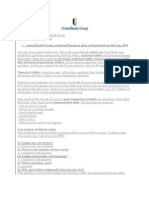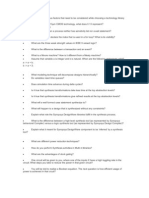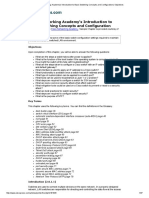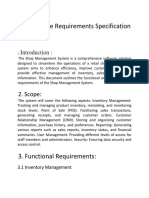GFI Agent Removing Procedure
Uploaded by
ayazbutt1GFI Agent Removing Procedure
Uploaded by
ayazbutt1Windows XP / 2003 1. Boot from Windows CD 2. Choose REPAIR (R) and select the installation to be repaired 3.
Type the password for the local Administrator 4. Enter the command: DEL C:\WINDOWS\system32\drivers\esecdrv42.sys 5. Enter the command: exit 6. Start Windows normally 7. Delete the following registry keys: HKLM\SYSTEM\CurrentControlSet\Services\EsecAgentSvc HKLM\SYSTEM\CurrentControlSet\Services\esecdrv HKLM\SYSTEM\CurrentControlSet\Services\esecdrv42 HKLM\SOFTWARE\GFI\EndPointSecurity4 8. Restart the computer 9. Delete the folder C:\Program Files\GFI\EndPointSecurity 4 Agent 10. Depending on the version of the agent, delete the registry keys as specified in Appendix A 11. From the GFI EndPointSecurity Console, remove the agent by selecting the option ?Delete computer(s) without uninstall? NOTE 1: In step 4, if the agent installed is version 4 or 4.1, the driver is called esecdrv.sys NOTE 2: In step 12, on x64 operating systems the GFI\EndPointSecurity registry key is located under HKLM\SOFTWARE\Wow6432Node\GFI Appendix A GFI EndPointSecurity 4.2 and 4.3 Builds:20100625 20100428 20091109 20091014 Keys: HKLM\SOFTWARE\Classes\Installer\Products\505AD1BC44D34744B81ED6B0071A1E23 and HKLM\SOFTWARE\Microsoft\Windows\CurrentVersion\Uninstall\{CB1DA505-3D44-44748BE1-6D0B70A1E132} GFI EndPointSecurity 4 and 4.1 Builds:20090508 20090217 20080215 Keys: HKLM\SOFTWARE\Classes\Installer\Products\09F8D729D7CAB5946B6907B2AD8DDEC7 and HKLM\SOFTWARE\Microsoft\Windows\CurrentVersion\Uninstall\{927D8F90-AC7D-495BB696-702BDAD8ED7C} NOTE: On x64 operating systems, the Uninstall\{<GUID>} registry key is located under HKLM\SOFTWARE\Wow6432Node\Microsoft\Windows\CurrentVersion\Uninstall
You might also like
- Butler Lumber - Pro Forma - Balance and Income Statement83% (6)Butler Lumber - Pro Forma - Balance and Income Statement4 pages
- @airbus: Component Maintenance Manual With Illustrated Part ListNo ratings yet@airbus: Component Maintenance Manual With Illustrated Part List59 pages
- CB Defense User Guide: CB Predictive Security CloudNo ratings yetCB Defense User Guide: CB Predictive Security Cloud178 pages
- Assignment On Job Description and Job Specification67% (6)Assignment On Job Description and Job Specification5 pages
- Mena-1 Monday Morning Round-Up: C C C C C C C C C C C C C C C C C CNo ratings yetMena-1 Monday Morning Round-Up: C C C C C C C C C C C C C C C C C C4 pages
- CC C C: 3: c4 C 5ccccccccccccccccccccc CNo ratings yetCC C C: 3: c4 C 5ccccccccccccccccccccc C2 pages
- Bvi NZM 12907 17-7-2011 MD Shahid (Rashid Ticket) p10No ratings yetBvi NZM 12907 17-7-2011 MD Shahid (Rashid Ticket) p101 page
- รายงาน Free Schools ตุลาคม - ธันวาคม 55No ratings yetรายงาน Free Schools ตุลาคม - ธันวาคม 5510 pages
- Kyn GKP Tat 11015 14-2-2012 Shaban M Asif & Yakuf (Ajmal Bhai Gaibi Nagar)No ratings yetKyn GKP Tat 11015 14-2-2012 Shaban M Asif & Yakuf (Ajmal Bhai Gaibi Nagar)2 pages
- CCCCCCCCCCCCCCCCCCCCCCC C CCC: C CC CC CCCCCCC CNo ratings yetCCCCCCCCCCCCCCCCCCCCCCC C CCC: C CC CC CCCCCCC C14 pages
- Altamar International Shipping Company IncNo ratings yetAltamar International Shipping Company Inc1 page
- HTK Kyn Tat 11012 13-8-2011 Mohd Akaram Pirani PadaNo ratings yetHTK Kyn Tat 11012 13-8-2011 Mohd Akaram Pirani Pada1 page
- Permit Solutions Tcs Pattern Instructions Before The TestNo ratings yetPermit Solutions Tcs Pattern Instructions Before The Test30 pages
- Kyn Ak 12111 14-8-2011 Shahrukh Iqbal P7No ratings yetKyn Ak 12111 14-8-2011 Shahrukh Iqbal P72 pages
- Jacobsob - Class Notes - All Chapters With IndexNo ratings yetJacobsob - Class Notes - All Chapters With Index66 pages
- C CCCCCCCCCCCCCCCC CC CCCCCCCCCCCCCCCCCCCCCCCCCCCCC C C C CCC CNo ratings yetC CCCCCCCCCCCCCCCC CC CCCCCCCCCCCCCCCCCCCCCCCCCCCCC C C C CCC C7 pages
- Evaluation of Some Android Emulators and Installation of Android OS on Virtualbox and VMwareFrom EverandEvaluation of Some Android Emulators and Installation of Android OS on Virtualbox and VMwareNo ratings yet
- Cómo formatear una computadora: Guía paso a paso para Windows, Mac y LinuxFrom EverandCómo formatear una computadora: Guía paso a paso para Windows, Mac y LinuxNo ratings yet
- Cisco Networking Academy's Introduction To Basic Switching Concepts and Configuration - ObjectivesNo ratings yetCisco Networking Academy's Introduction To Basic Switching Concepts and Configuration - Objectives37 pages
- 4 Way 4 Port VGA LCD Monitor Switch 4 To 1 Selector Box: Product FeaturesNo ratings yet4 Way 4 Port VGA LCD Monitor Switch 4 To 1 Selector Box: Product Features2 pages
- St. Mary Magdalene Parochial School of Amadeo Cavite, IncNo ratings yetSt. Mary Magdalene Parochial School of Amadeo Cavite, Inc2 pages
- Parameters For Selection of Pumps For Different Applications67% (3)Parameters For Selection of Pumps For Different Applications10 pages
- Smart Mold: Real-Time In-Cavity Data AcquisitionNo ratings yetSmart Mold: Real-Time In-Cavity Data Acquisition8 pages
- Advanced Systemcare Pro 12.6.0.368 Crack With License KeyNo ratings yetAdvanced Systemcare Pro 12.6.0.368 Crack With License Key2 pages
- MBA 502 Supply Chain Management Lesson 2No ratings yetMBA 502 Supply Chain Management Lesson 244 pages
- AXIOM™ 12 Cup Automatic Coffee Brewer: FeaturesNo ratings yetAXIOM™ 12 Cup Automatic Coffee Brewer: Features2 pages
- Complete Download Working as a Data Librarian A Practical Guide Eric O. Johnson PDF All Chapters100% (2)Complete Download Working as a Data Librarian A Practical Guide Eric O. Johnson PDF All Chapters65 pages
- Software Requirements Specification: 2. ScopeNo ratings yetSoftware Requirements Specification: 2. Scope4 pages
































































































